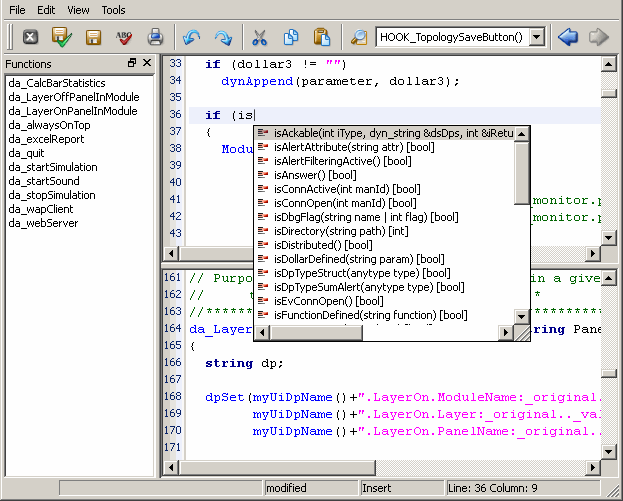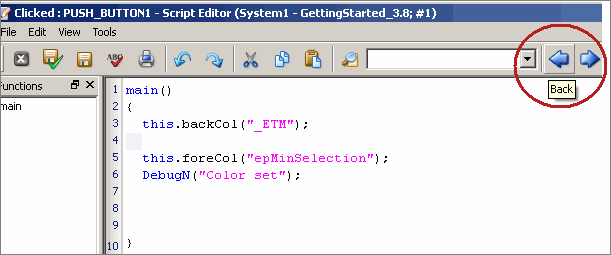The Script Editor
The Script Editor is used for creating and editing CTRL scripts and libraries.
You can open the script editor from the menu or .
The Script Editor can be started as a separate window in a UI Manager. This is done with the option "-editor", optionally a specific file can be opened.
In case of graphic objects, you can program the desired code directly for the specific event. This means that you program the code, for example, for the "Initialize" event (the code will be executed when initialized) or for the event "DoubleClicked" (the code is executed when you double-click on the object).
The script editor can also be opened using CTRL+E. The panel or a specific object as well as an event (for example, doubleClicked) can be selected on the left side. However, a script cannot be changed simultaneously using two different script editors (for example, editor opened using CTRL+E and editor opened using the property sheet).
What events are available for the objects is described in chapter Events of graphics objects.
The script editor is opened with an empty script.
The script editor contains a menu bar with four menus File, Edit, View, Tools.

You can indent a selected row or decrease the indent using the tabulator key. For tabulator settings see chapter The Edit menu.
The script editor provides a number of specific input helps (hotkeys) to facilitate working in the script editor. For a list of these input helps see The Control Editor.
In the figure above, the function names that start with "is" are shown as the cursor is at the position "is" when the tabulator key was pressed. Thus, the characters of the function name and the tabulator key can be used to show all functions starting with or containing this specific character.
CTRL + space shows the function tooltip when the cursor is inside the function arguments.
The buttons of the script editor offer you the same functions as the Edit menu.

In addition, you can save the code and check the syntax. For as long as the code does not match the syntax, the editor can only be closed by explicitly acknowledging an additional save dialog.
By clicking on Close (black X) on the top right, a message appears for saving the changes in the script. Yes saves the script and closes the Script Editor whereas No closes the Script Editor without saving the changes and Cancel returns to the actual script in the Editor. Additionally, the symbol bar provides the position history.
The history contains up to 30 steps. You can switch between different positions by moving forward and back, similar to a web browser. See the following figure.

Auto-completion
- The auto-complete function can either be shown upon typing or be activated via the TAB-key. This behaviour
can be defined via the settings. The Script Editor EWO uses the property
autoCompletionfor this. - The auto-completion list adds entries where the partial string matches in the middle, to the end of the suggestion list, in cursive font.
- The panel name can be added from the autocomplete list. This can either be activated for panel names whose path is collected from all paths in the project, with the TAB key within any ChildPanelOn* or RootPanelOn* function, when a string has already been started (i.e.: " character typed). Or it is activated explicitly for panelnames with the ALT + P combination when inside any string.
- If the panel script editor is used, the autocomplete function only displays all entries that relate to the current shape.
Editor Config
The Script Editor now supports the use of a Editor Config to import Settings.
The Script Editor now checks for an ".editorconfig" file when opening any script or library or panel-script or also when opened (e.g. when opening a non-existing new file or a string (e.g. with the function scriptEditor()).
In the Script Editor settings dialog, a note will be displayed at the bottom if the current editor instance is using any ".editorconfig" file. In this case the settings concerning tabs/indents/etc., which are also defined in the ".editorconfig" file, will not be used from this settings dialog but only from the ".editorconfig" file. In the settings dialog, a new ".editorconfig" file can be created in the project root directory.
Additional Notes on Functionality
- If you write a function and the left parenthesis, a tooltip is shown for the function. The tooltip shows the parameters and the data types. For user-defined functions, default values are also shown.
- Not only CTRL functions but also library functions are available.
- When using classes (see Object Oriented Scripting (CTRL++)), the definition of a class can be opened by using the right click context menu on the class instance.
- Additional dock modules can be added with the moduleAddDockModule() function.
- The Script Editor can automatically format code in astyle with the keys CTRL + ,. A standard configuration is included, but you can create your own configuration file, which is saved as "astyle.config" and will be searched for in all config directories.
- The script editor colors class members. The color is only used if the function call statement is within a function of this class, but not on an instance of a class. e.g:
class X { foo() { } bar() { foo(); // uses color SomeClass c; c.someFunc(); // not using color } }; - Mismatching return value/function definition leads to a syntax error, and no longer allows the execution of this script.
- The function you are currently in is highlighted in the functions box.
- You can jump to the start of the current function with CTRL + H or via the menu .
- The shortcuts CTRL and PageUp or PageDown allow scrolling page by page.
- Hovering over a variable shows the variable type in the tooltip.
- Select whole lines with the CTRL + UP or CTRL + DOWN keys.
- Cut and copy operations without selection affect the entire line the cursor is in.
- The Script Editor can parse encrypted scripts and use the API information to be shown in the auto-completion and tooltips.
- When the script editor is used with a ESXi Server the 3D acceleration must be activated.



